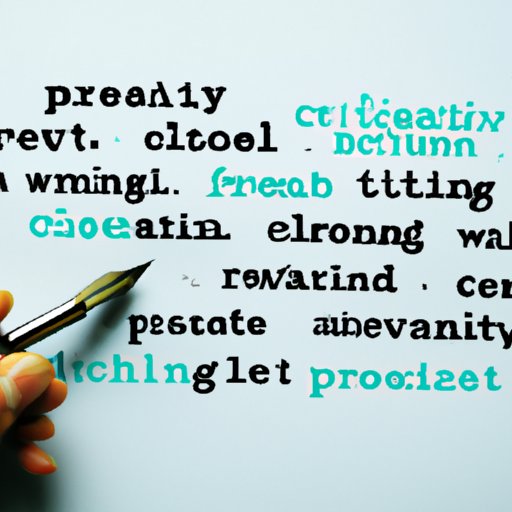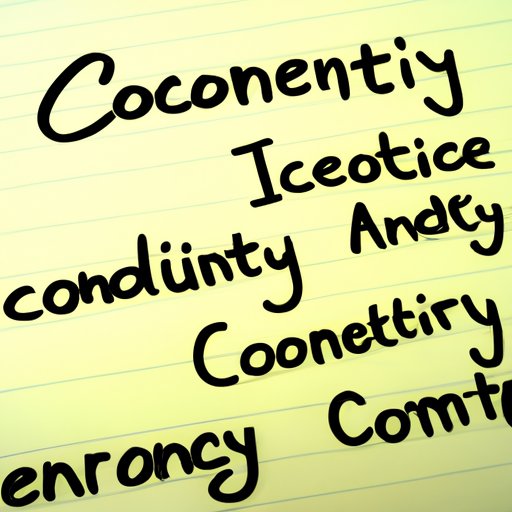Introduction
Good writing is a skill that can take years to perfect. But what exactly is “good writing”? Put simply, good writing is clear, concise, and creative. It conveys an idea or message in a way that is easily understood and engaging. In this article, we will explore the elements of good writing, examine examples of effective writing techniques, discuss the benefits of clear and concise writing, investigate the use of creative language, outline the role of grammar and punctuation, and provide strategies for crafting engaging content.
Analyzing the Elements of Good Writing
When it comes to writing, there are four key elements that make up good writing: clarity, coherence, concision, and creativity. Clarity refers to the ability to communicate a message in a straightforward manner. Coherence is the way in which ideas are logically connected and presented. Concision means using fewer words to get your point across. And creativity involves using language in a unique and imaginative way.
Examining Examples of Effective Writing Techniques
Now that we’ve discussed the elements of good writing, let’s examine some effective writing techniques. Show, don’t tell is a popular technique that encourages the writer to use vivid descriptions rather than telling the reader what to think or feel. Varying sentence length adds interest and flow to a piece of writing. Using active voice instead of passive voice helps to make sentences more direct and powerful. And choosing precise words that accurately convey the intended meaning is essential for good writing.

Exploring the Benefits of Clear and Concise Writing
Writing clearly and concisely has numerous benefits. For one, it enhances understanding. When writing is clear and easy to follow, readers are able to comprehend the message without confusion. Additionally, clear and concise writing increases engagement. Readers are more likely to continue reading if they can understand what they’re reading. Finally, clear and concise writing improves efficiency. When writers are able to express their thoughts in fewer words, they can save time and energy.

Investigating the Use of Creative Language in Writing
Creative language is an important part of good writing. Word choice is a great way to add creativity to a piece of writing. By selecting words that are descriptive and evocative, writers can bring their writing to life. Metaphors and similes are also useful tools for adding creativity to writing. These figures of speech allow writers to compare two things in an interesting and unexpected way. Alliteration is another great tool for creating memorable phrases and making writing more interesting.

Discussing the Role of Grammar and Punctuation in Writing
Grammar and punctuation are essential for good writing. Accuracy is key when it comes to grammar and punctuation; using them correctly helps ensure that your meaning is conveyed accurately. Clarity is also important; using proper grammar and punctuation enables readers to understand your message without confusion. Finally, consistency is essential; using the same rules throughout a piece of writing helps maintain a consistent style.
Outlining Strategies for Crafting Engaging Content
To craft engaging content, there are several strategies that writers can employ. Creating a strong introduction is one way to draw readers in and keep them interested. Supporting ideas with evidence helps to make your argument more convincing. Using transitions between paragraphs or sections keeps the text flowing smoothly. And including a call to action at the end of a piece of writing encourages readers to take action.
Conclusion
In conclusion, good writing is clear, concise, and creative. It conveys an idea or message in a way that is easily understood and engaging. To achieve this, writers need to analyze the elements of good writing, examine examples of effective writing techniques, explore the benefits of clear and concise writing, investigate the use of creative language, discuss the role of grammar and punctuation, and outline strategies for crafting engaging content. With these tips, writers can create pieces of writing that are both informative and enjoyable to read.
(Note: Is this article not meeting your expectations? Do you have knowledge or insights to share? Unlock new opportunities and expand your reach by joining our authors team. Click Registration to join us and share your expertise with our readers.)
